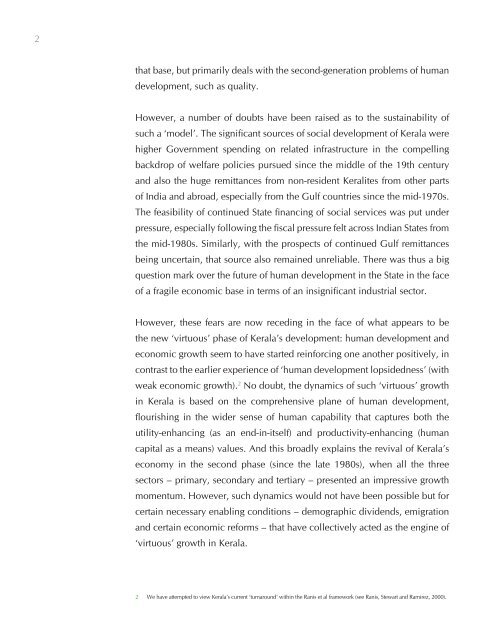Kerala 2005 - of Planning Commission
Kerala 2005 - of Planning Commission
Kerala 2005 - of Planning Commission
You also want an ePaper? Increase the reach of your titles
YUMPU automatically turns print PDFs into web optimized ePapers that Google loves.
2<br />
that base, but primarily deals with the second-generation problems <strong>of</strong> human<br />
development, such as quality.<br />
However, a number <strong>of</strong> doubts have been raised as to the sustainability <strong>of</strong><br />
such a ‘model’. The significant sources <strong>of</strong> social development <strong>of</strong> <strong>Kerala</strong> were<br />
higher Government spending on related infrastructure in the compelling<br />
backdrop <strong>of</strong> welfare policies pursued since the middle <strong>of</strong> the 19th century<br />
and also the huge remittances from non-resident Keralites from other parts<br />
<strong>of</strong> India and abroad, especially from the Gulf countries since the mid-1970s.<br />
The feasibility <strong>of</strong> continued State financing <strong>of</strong> social services was put under<br />
pressure, especially following the fiscal pressure felt across Indian States from<br />
the mid-1980s. Similarly, with the prospects <strong>of</strong> continued Gulf remittances<br />
being uncertain, that source also remained unreliable. There was thus a big<br />
question mark over the future <strong>of</strong> human development in the State in the face<br />
<strong>of</strong> a fragile economic base in terms <strong>of</strong> an insignificant industrial sector.<br />
However, these fears are now receding in the face <strong>of</strong> what appears to be<br />
the new ‘virtuous’ phase <strong>of</strong> <strong>Kerala</strong>’s development: human development and<br />
economic growth seem to have started reinforcing one another positively, in<br />
contrast to the earlier experience <strong>of</strong> ‘human development lopsidedness’ (with<br />
weak economic growth). 2 No doubt, the dynamics <strong>of</strong> such ‘virtuous’ growth<br />
in <strong>Kerala</strong> is based on the comprehensive plane <strong>of</strong> human development,<br />
flourishing in the wider sense <strong>of</strong> human capability that captures both the<br />
utility-enhancing (as an end-in-itself) and productivity-enhancing (human<br />
capital as a means) values. And this broadly explains the revival <strong>of</strong> <strong>Kerala</strong>’s<br />
economy in the second phase (since the late 1980s), when all the three<br />
sectors – primary, secondary and tertiary – presented an impressive growth<br />
momentum. However, such dynamics would not have been possible but for<br />
certain necessary enabling conditions – demographic dividends, emigration<br />
and certain economic reforms – that have collectively acted as the engine <strong>of</strong><br />
‘virtuous’ growth in <strong>Kerala</strong>.<br />
2 We have attempted to view <strong>Kerala</strong>’s current ‘turnaround’ within the Ranis et al framework (see Ranis, Stewart and Ramirez, 2000).

















